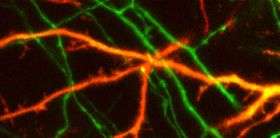Efficient technique enables thinking

(PhysOrg.com) -- Nerve cells constantly create new contact points to their neighbouring cells. This is how the basic structure of our brain develops. In adults, new contact makes learning and memory possible. However, not all contact between cells is useful - most of it is dismantled again very quickly. Scientists at the Max Planck Institute for Neurobiology in Martinsried near Munich have now described a completely new technique with which nerve cells can evaluate the quality of the cells they contact in a very time- and energy-saving way. (Neuron, July 31, 2008)
The brain consists of a hundred billion nerve cells. What’s more, each of these cells is linked to its neighbours by many thousands of contact points. During brain development, young nerve cells must come into contact with the correct partner cells so that the brain can carry out its complex functions. However, contact between nerve cells is also constantly being set up and dismantled in adults. It is this continuous restructuring of the brain that allows us to learn and to forget.
Complex brain restructuring
Building and rebuilding the brain uses up a great deal of energy - it is not for nothing that the brain is the organ with the highest energy consumption. In reality, it should actually be consuming much more energy. This is because both young and adult nerve cells allow many hundreds of cell extensions to grow towards their neighbours. If the cells make contact, they need to exchange information about the quality of the connection: if the cells do not fit optimally together, the extension is broken down again after a short time, ranging from just a few seconds to a few minutes.
Up to now, it had been assumed that nerve cells can only exchange information via the synapses which are special contact points. However, synapses require up to two days to become fully functional - a waste of time and energy if the contact is to be broken down again. The brain could take almost 1000 years to develop if a synapse had to mature at each cell contact.
Calcium: the key to efficiency
It appears that nerve cells can also obtain information about their neighbours even without a synapse. Neurobiologists Christian Lohmann and Tobias Bonhoeffer from the Max Planck Institute for Neurobiology have now explained how they do that. The scientists marked a number of nerve cells with fluorescent dyes, observed them under a special microscope and discovered the secret to how the information is exchanged: local calcium signals very quickly transmit all the necessary information to the cell. A synapse only actually develops when the cell and the contact point prove to be suitable candidates for long-term contact.
How does this work in concrete terms? When a lengthening extension encounters a neighbouring cell, a release of calcium is triggered at its base. This calcium signal then acts like a stop sign: the extension immediately ceases to grow. At the same time, this signal already contains all the important information about the quality of the new contact: the contact only remains intact if the calcium signal is significantly higher than the surrounding calcium level of the cell. Otherwise, the extension withdraws and the nerve cell searches for a suitable partner cell at another point.
Suitable for both young and old
"We were astounded by the efficiency of this technique," says Tobias Bonhoeffer. "It saves the brain time and energy, and at the same time collects important information - in passing, so to speak." The scientists assume that nerve cells in adult brains use the same method to weigh up their partner cells. This allows the correct partner cell to be found quickly and a thought to be completed.
Citation: Christian Lohmann and Tobias Bonhoeffer, A role for local calcium signaling in rapid synaptic partner selection by dendritic filopodia, Neuron, July 31, 2008
Provided by Max Planck Institute of Neurobiology





















